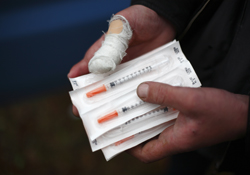Drugs

WHO/Piotr Malecki
A disproportionate number of prisoners in Europe have personal histories of drug use and many enter prison with severe drug problems. Approaches to reduce harm recognize that many drug users cannot totally abstain from using psychoactive substances in the short term. They therefore aim to help drug users not to start injecting drugs, to either stop or reduce injection frequency and to increase injection safety.
All prison systems should consider taking important additional harm-reduction measures:
- developing a planned and comprehensive clinical treatment programme for drug-dependent prisoners, including the use of opiate substitution maintenance therapy;
- developing a needle exchange programme equivalent to that available in the community, especially if the local prevalence of HIV or hepatitis C is high or if injecting drug use is known to occur in the prison; and
- providing an effective method for disinfecting needles and tattooing instruments, along with appropriate information and training, if needle and syringe exchange is not considered necessary or feasible.
Ex-prisoners have a higher risk of overdose death than the general population, particularly in the first two weeks following release. Overdose deaths result from many factors, including decreased tolerance after a period of relative abstinence during imprisonment and the concurrent use of multiple drugs. Other important factors are the lack of pre-release counselling and post- release follow-up, and the failure to identify those at risk. There is good evidence from trials and cohort studies that opioid substitution treatment reduces the risk of overdose among opioid users.



